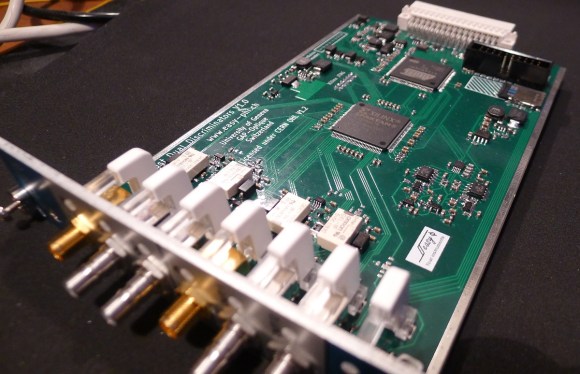A few months ago I presented you the Easy-phi project, which aims at building a simple, cheap but intelligent rack-based open hardware/software platform for hobbyists. With easy-phi, you simply have a rack to which you add cards (like the one shown above) that perform the functions you want.
Recently my team finished testing our FPGA-based discriminator or “universal input” if you prefer. As easy-phi cards use a well-defined electrical signal to communicate with each other, we needed to make a card that would translate the different kinds of electrical signals from the outside, as well as perform plenty of other functions. It was therefore designed to have a 100MHz input bandwidth with an AC/DC coupled 50 ohm/high impedance input stage (x2) and 4 easy-phi outputs. For this module, we picked the (old) spartan3-an FPGA to perform the different logic functions that may be needed by the final users (high speed counter, OR/XOR/AND, pulse creation,…). Using the cortex-m3 microcontroller present on the board, it may be easily reconfigured at will. All design resources may be found on our Github, and you can always have a look at our official website.
















Did anyone done any analysis on the input analog circuit (e.g. Spice)?
I am looking at R64(50 ohm) and C55(100pF) in series across the input to
ground. The “high” impedance mode is 209 ohms at 10MHz and 66 ohms at
100MHz. Because of that high capacitance load, you wouldn’t be able to
use an old scope 10X probe to its input.
You might want to take a look at the reverse engineer schematic of the
Rigol scope. http://rigol.codenaschen.de/index.php/Schematics
Hey tekkieneet,
Thanks a lot for having taken the time to read the article in details.
You’re right! My colleague shouldn’t have put 100pF, he actually didn’t perform this calculation. We even may not need to add a capacitor as the relay pad capacitance may be enough.
Thanks a lot for the link!
BTW I only gave the circuit a 30 seconds look, so I probably missed a lot. Back of my mind was reminding me last night that I missed something.
C20 (100nF) and R64 (50 ohms) forms a high pass filter (~32kHz) when the 50 ohms input is selected.
what do you define as “low cost”?
I can’t find any price estimates /target range on this (maybe overlooked it on your site).
It was in the conclusion ;). Total cost should be less than $200.
ha totally overlooked your blog, I went to the “official website” and browsed there
Will you make eagle sources available?
Will you make your Eagle sources available?
All kicad files are available on the github